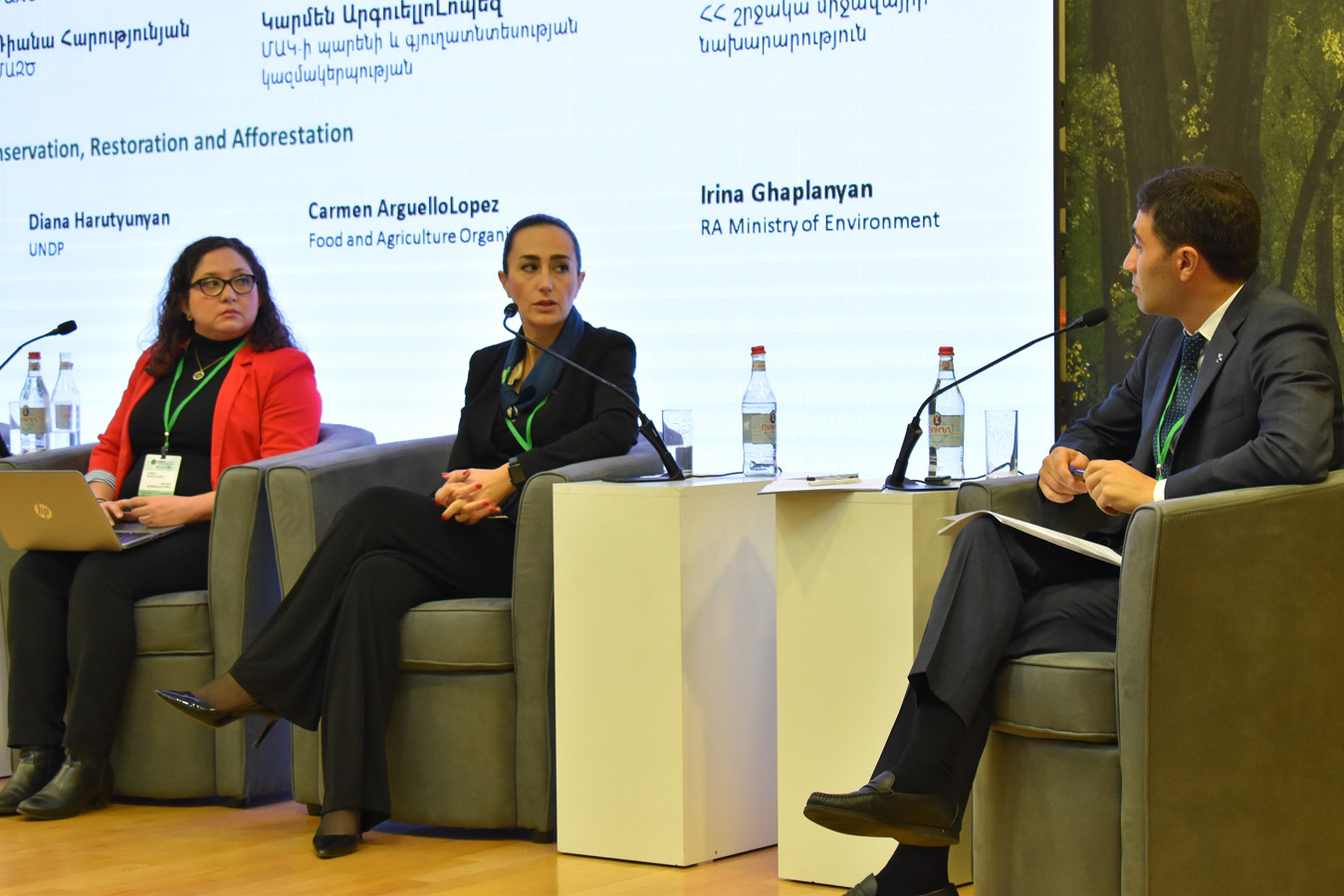
Armenia has made an ambitious commitment to double its forest cover by 2050 as part of its pledge to the Paris Agreement on Climate Change. Aside from the policy and technical challenges, one hurdle is how to fund such a major undertaking. Given the scope of this issue, AUA Acopian Center for the Environment and Armenia Tree Project convened a panel on financing mechanisms on day two of the inaugural “Forest Summit: Global Action and Armenia” held in October 2019.
The speakers were Irina Ghaplanyan, Deputy Minister of Environment; Carmen Arguello Lopez, Green Climate Fund advisor for FAO’s Regional Office for Europe and Central Asia; Diana Harutyunyan, UNDP Climate Change Program Coordinator; and Glenn Bush, assistant scientist at Woods Hole Research Center. This panel was moderated by UNDP Impact Investment Advisor Vahagn Voskanyan.
Deputy Minister of Environment Irina Ghaplanyan set the stage for this important topic by outlining the issues around Armenia’s goal to double the forest cover. She announced that more than 250,000 hectares of land may be needed to expand the forest at this scale at a cost of nearly $800,000,000. She acknowledged that Hayantar does not have a large nursery capacity to grow the seedlings needed, but that ATP has several tree nurseries and greenhouses in operation and MyForest, a new NGO, is establishing its first nursery. All of these nurseries will help to support the government’s effort to double the tree cover, explained Dr. Ghaplanyan, and the government is partnering with FAST Foundation to create tools to monitor the work and utilize new technology.
Turning to financing, Dr. Ghaplanyan pointed out that Armenia is a signatory to the Paris Agreement and there is an expectation that developed countries will fund programs like this as part of the fight against climate change. The funds available are expected to be $100 billion worldwide annually starting in 2020. There is a shortage of global programs which can effectively mobilize funding at this scale. Armenia has been developing a climate finance mechanism around debt for nature swaps. For example, Armenia has $1 billion in bilateral debt. Negotiations are underway with France, which will help developed countries meet their commitment under the Paris Agreement. If the mechanism works between Armenia and France, it can possibly be scaled up for other developing countries.
Carmen Arguello Lopez provided several recommendations to help Armenia access climate finance. These include the need for strong in-country coordination, discussions with in-country stakeholders to develop transformational projects, and understanding all types of financial instruments available in addition to grants. She cautioned that working with the Green Climate Fund can be a long process, with two years for a project to be approved and implementation over a period of eight to ten years. Short term thinking can be a limiting factor.
Next, climate change expert Diana Harutyunyan highlighted other conservation finance mechanisms which can be better utilized in Armenia, including environmental taxes since forests provide valuable ecosystem service benefits including soil and water protection. The opportunity exists to monetize the biodiversity value of Armenia’s forests by attracting funding from private sector companies doing business in Armenia that receive benefits from the environment including the beverage industry and the mining industry. She noted an issue around financing that is often overlooked in Armenia. In addition to planting new forests, there is a need to protect existing forests, because protection and sustainable forest management is usually more cost-effective than replanting new forests.
Glenn Bush, an environmental economist at Woods Hole Research Center, rounded out this panel with additional insights on financing mechanisms. He pointed out that good data is necessary for projects to be successful, both in terms of project management and measurement of impact. The funds mentioned in this panel are highly oriented toward having a large-scale impact.
“The challenge in Armenia for the next 30 years is to define how much forest and what type is needed, and where they need to be planted. By going through this process and evaluating if forests are needed for production, for fuelwood, for ecosystem service benefits, you can start to identify the impact and performance framework that needs to be monitored,” explained Dr. Bush.
Reflecting on his experiences in Africa, Latin America, and Eastern Europe, Dr. Bush pointed out that many of the climate funds are looking for “payments for performance” frameworks, where disbursements are made after an agreed upon set of impacts to unlock the next tranche of funding. He cautioned that this requires strategic planning and management, and an impact assessment to measure if the projects actually achieved what they set out to do.
He explained that many of the funds go beyond measuring carbon reductions from planting new forests. Often it’s necessary to measure social and economic metrics, he said. Recognizing the challenge of measuring and monitoring when resources and capacity are limited, he recommended developing a set of measurements that allow you to “measure once and report twice” to the various funders as a way of keeping costs down. Many of the performance metrics are the kinds of data that Armenia may already be collecting, like government metrics on social impacts, and standard of living.
Internationally, programs exist to provide debt-for-nature swaps and carbon offsets. As discussed in this panel, in order to become eligible for participation in such programs Armenia must conduct a thorough inventory of existing forests and develop detailed mechanisms to track new plantings and monitor survival rates. Many of the participants at the Forest Summit have successfully assisted other countries in achieving eligibility, and Armenia should consult with them as plans evolve.
“This panel provided recommendations that many organizations and policymakers can follow. ATP, for example, is always interested in accessing funds to scale up our work,” noted Executive Director Jeanmarie Papelian.


Be the first to comment